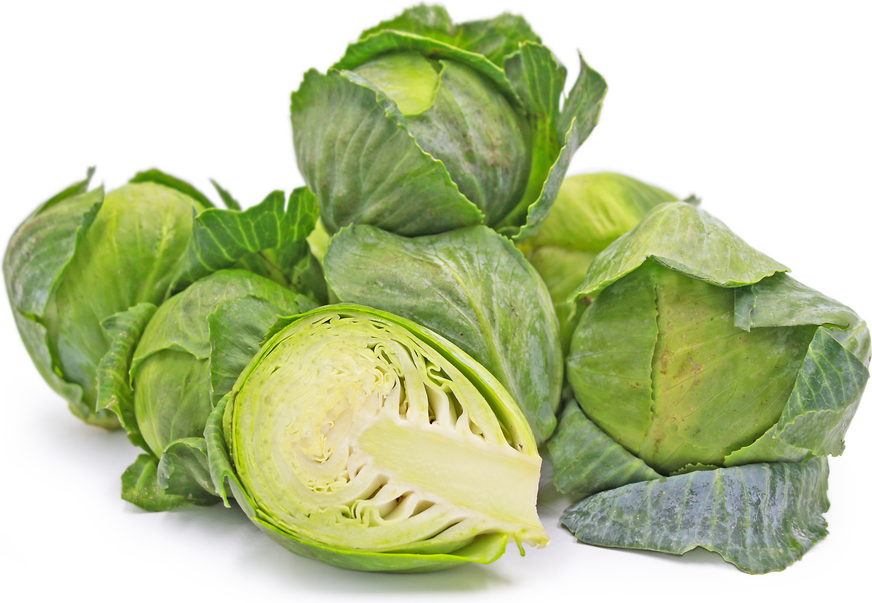


Pixie Cabbage
Estimated Inventory, ea : 0
Description/Taste
Pixie cabbage is a miniature version of conventional green cabbage, measuring approximately 12.5 to 15 centimeters in diameter. This vegetable has a round to ovate shape, densely packed with layers of leaves that form a round, sometimes slightly pointed head. These leaves feature ridged, vertical lines that branch out from a central stem. The outer leaves may have a white residue on them. Towards the center of the cabbage, the leaves become more tightly condensed and transition into a lighter green hue that's almost white at the very core. The stem at the center of the vegetable is dense, hard, and not easily bitten into when raw. Pixie cabbage has a crisp bite and a delicate, sweet flavor, with its sweetness most pronounced when raw.
Seasons/Availability
Pixie cabbage is available from late spring to mid-summer and again from mid-fall to early winter.
Current Facts
Pixie cabbage is botanically known as Brassica oleracea and belongs to the Brassicaceae family, which also includes kale, broccoli, and Brussels sprouts. Along with these vegetables, Pixie cabbage is considered cruciferous, tending to be high in nutrients and low in calories. The cabbage species derives its name from the French word caboche, which translates to head and is the origin of the term cabbage head. There are over 400 different types of cabbage in many different sizes, colors, and shapes. Miniature varieties like Pixie cabbage have grown in popularity due to their ability to thrive in smaller spaces, allowing them to be sown closely together. This variety is an early-season cabbage known for its small size and sweet flavor. It's also fast-growing, maturing between 45 and 60 days.
Nutritional Value
Pixie cabbage is an excellent source of calcium, which is essential for maintaining strong bones and teeth, and plays a vital role in muscle function and nerve transmission. With its high vitamin C content, Pixie cabbage supports a healthy immune system, promotes collagen production for skin health, and aids in iron absorption. This cabbage variety also contains iron, which is crucial for the formation of red blood cells and the transportation of oxygen throughout the body. Pixie cabbage is rich in vitamin K, which is important for blood clotting and bone health. The presence of folate makes it beneficial for cellular function and tissue growth, particularly during pregnancy. Its manganese contributes to metabolic processes, while its fiber content promotes digestive health, aids in weight management, and helps regulate blood sugar levels. When served raw, pickled, or fermented with vinegar and spices, Pixie cabbage further supports healthy digestion.
Applications
Pixie cabbage can be used in many applications that call for conventional cabbage. Its small size makes it an ideal cabbage to use for one whole meal. This variety can be chopped and added to green or potato salads or incorporated into traditional summer coleslaw. It can also be layered into sandwiches or used to add sweetness and crunch atop tacos. Chopped or diced Pixie cabbage can be sautéed, stir-fried, and steamed. It can also serve as an ingredient in kimchee, sauerkraut, and other fermented vegetable preparations. To store, keep Pixie cabbage wrapped in plastic in the crisper drawer of the refrigerator where it can keep for two to three weeks. Once the cabbage is cut, it should be used within a few days.
Ethnic/Cultural Info
Cabbage has always been sustainable, easy to grow, and relatively affordable, making it a staple in Central and Northern Europe during the Middle Ages and Renaissance despite its controversial reputation. During this time, this vegetable was often associated with peasants and regarded by the nobility as a lowly food, partly because of its strong smell when cooked. Some believed that cabbage, along with crops like beans, onions, and garlic, contributed to the spread of deadly illnesses like the Bubonic Plague, which swept through Europe from the 14th to 17th century. These beliefs came from the miasma theory, which falsely stated that diseases were spread by foul odors or bad air from rotting matter. Despite this misconception, cabbage remained a crucial crop for peasants due to its low cost, resilience, and widespread availability. In regions like Avranches, France, cabbage was so important that it occupied half of the plant space in the rented gardens where peasants harvested their vegetables.
Geography/History
Pixie cabbage is believed to have originated in England. It can be grown in climates that provide full sun and nutrient-rich, well-drained soils. It is hearty and fairly tolerant of both heat and frost. Pixie cabbage is a cultivated variety bred for its small size, sweet flavor, and compact growth and is therefore not found in the wild but sown at small farms and private gardens. Pixie cabbage dates back to at least the 1800s, with a mention appearing in the American Agriculturalist under New and Rare Seeds for 1867. Its rise in popularity can be credited to receiving the Award of Garden Merit from the British Royal Horticultural Society. Pixie cabbages are a relatively niche variety that is more likely to be purchased from seed to be grown in home gardens than found in stores.
Recipe Ideas
Recipes that include Pixie Cabbage. One
| The Food Site |
|
Easy Pixie Cabbages Stir Fry |




